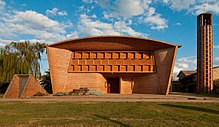| Iglesia de Cristo Obrero y Nuestra Señora de Lourdes | |
|---|---|
 Façade of the Iglesia de Estación Atlántida, 2011 Façade of the Iglesia de Estación Atlántida, 2011 | |
| Religion | |
| Affiliation | Roman Catholic |
| Rite | Roman Rite |
| Ecclesiastical or organizational status | Parish church |
| Year consecrated | 1960 |
| Status | Active |
| Location | |
| Location | Estación Atlántida, Uruguay |
 | |
| Geographic coordinates | 34°44′38″S 55°45′59″W / 34.74392°S 55.7664°W / -34.74392; -55.7664 |
| Architecture | |
| Architect(s) | Eladio Dieste |
| Type | Church |
| Style | Modernist |
| Materials | Brick |
| UNESCO World Heritage Site | |
| Official name: The work of engineer Eladio Dieste: Church of Atlántida | |
| Criteria | Cultural: (iv) |
| Designated | 2021 (44th session) |
| Reference no. | 1612 |
| State Party | Uruguay |
| Region | Latin America |
The Church of Christ the Worker and Our Lady of Lourdes (Spanish: Iglesia de Cristo Obrero y Nuestra Señora de Lourdes), also known simply as Iglesia de Estación Atlántida, is a Roman Catholic parish church and a World Heritage Site in Estación Atlántida, Uruguay.
Description
The temple is dedicated to Christ the Worker and Our Lady of Lourdes. It constitutes a renowned architectural landmark, it was designed in 1958 by the engineer Eladio Dieste. It is architecturally striking, described as "a simple rectangle, with side walls rising up in undulating curves to the maximum amplitude of their arcs" these walls supporting a similarly undulating roof, composed of a sequence of reinforced brick Gaussian vaults developed by Eladio Dieste.
The cylindrical bell-tower, built in openwork exposed brick masonry, rises from the ground to the right of the main church facade, while the underground baptistery is located on the left side of the parvis, accessible from a triangular prismatic entrance and illuminated via a central oculus.
The Church provides an eminent example of the remarkable formal and spatial achievements of modern architecture in Latin America during the second part of the 20th century, embodying the search for social equality with a spare use of resources, meeting structural imperatives to great aesthetic effect.
The material is a very simple brickwork, which conforms a novel utilization of exposed bricks in a reinforced ceramics structure.
In 2021 the Church was proclaimed as a UNESCO World Heritage Site under the name "The work of engineer Eladio Dieste: Church of Atlántida".
References
- "Cristo Obrero". Diocese of Canelones. Archived from the original on 20 June 2014. Retrieved 11 May 2013. (in Spanish)
- Porley, Carolina (28 April 2017). "The other creators". Brecha. (in Spanish)
- Iglesia Cristo Obrero y Nuestra Señora de Lourdes Archived 2016-03-13 at the Wayback Machine (in Spanish)
- Ching, Frank; Jarzombek, Mark; Prakash, Vikramaditya (2007). A global history of architecture. J. Wiley & Sons. p. 732. ISBN 978-0-471-26892-5. Retrieved 30 May 2011.
- UNESCO (27 July 2021). "Cultural sites in Africa, Arab Region, Asia, Europe, and Latin America inscribed on UNESCO's World Heritage List". UNESCO. Retrieved 27 July 2021.
External links
| World Heritage Sites in Uruguay | ||
|---|---|---|
| ||
This article about a Christian church building in Uruguay is a stub. You can help Misplaced Pages by expanding it. |
- Roman Catholic churches completed in 1960
- Roman Catholic church buildings in Canelones Department
- Modernist architecture in Uruguay
- Eladio Dieste buildings
- 20th-century Roman Catholic church buildings in Uruguay
- World Heritage Sites in Uruguay
- South American church stubs
- Uruguayan religious building and structure stubs
